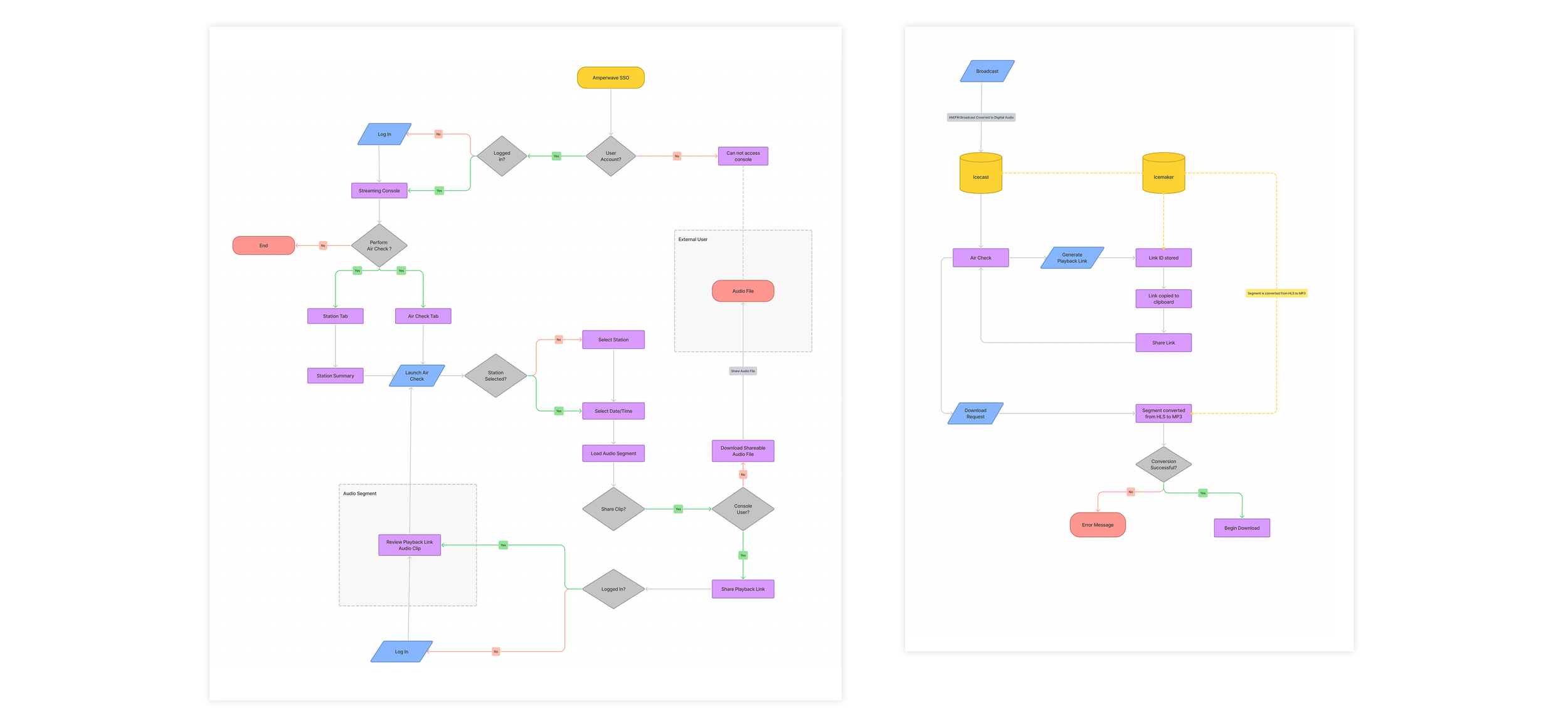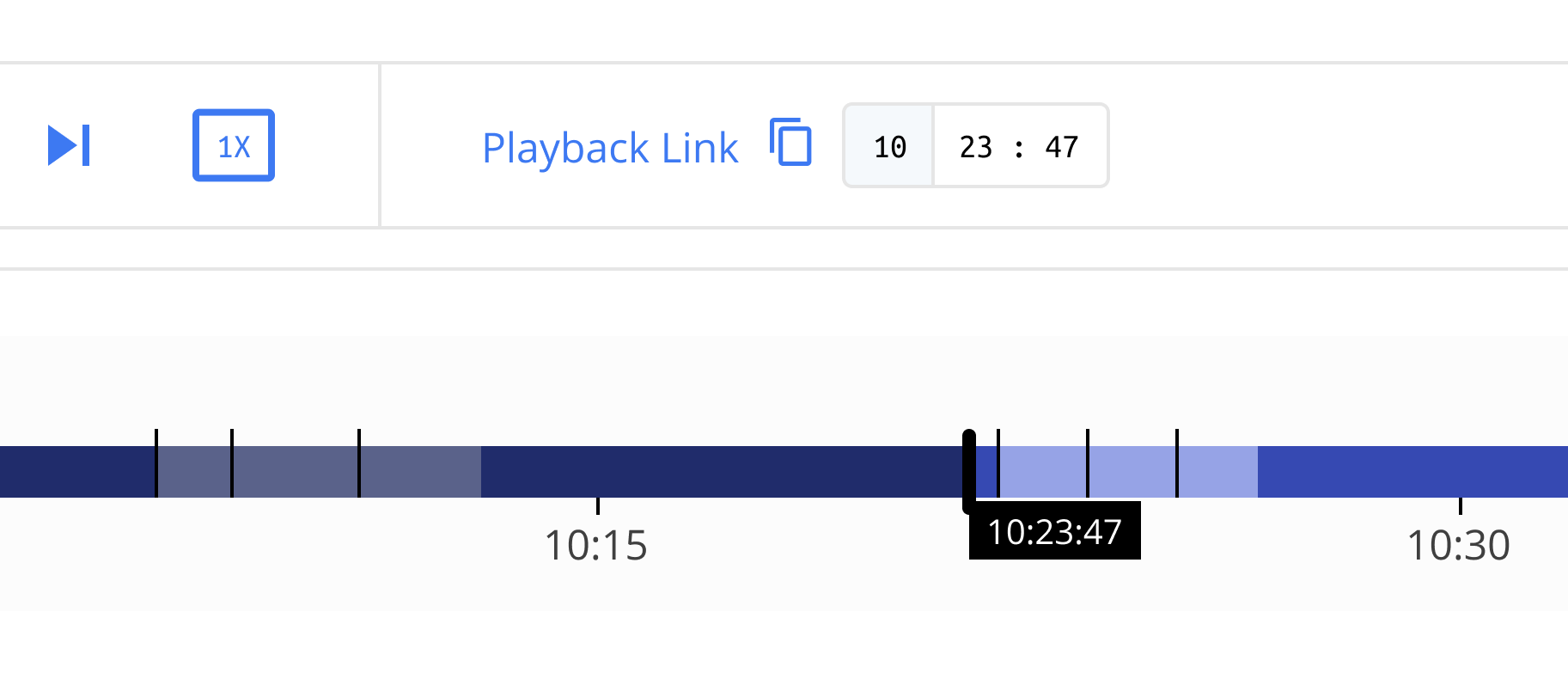
Station Air Check
Air Check allows broadcasters and advertisers to listen to, review, and share previously-aired digital audio content across multiple markets, helping advertisers understand how ads play out and identify mistargeted ad content.
MY ROLE: Research, Feature Definition, and UX Design

Project Goals
Define key use cases and features.
Design a player that allows previously played segments of audio to be shared.
Provide producers for large markets an easy way to monitor on-air talent and ad play.
Visualize ad breaks within content.
Add stream transcription and meta data, with language detection and flagging.
Process
The design and release of this product took a phased approach, allowing us to ship quickly and meet immediate business needs while we defined additional feature sets. It was also driven by the need to support two distinct audiences. Our research identified a primary audience, producers and radio station managers and a secondary audience, ad insertion teams, operations teams, and station executives. Our primary audience has direct access through their Amperwave user accounts, but our secondary audience did not, and could not review aired audio content. The first problem to solve was how user with accounts could support our secondary audience who also needs to review audio content.
Working with our end-users and engineering team we ranked features by priority. The first problem to solve was supporting access the aired audio whether the user has an Amperwave account or not. We provided both audiences the ability to monitor, review, and share aired content through a permalink and downloadable file. Focusing on our primary goal in the initial releases gave us time to further develop our requirements and to test design ideas with prototyping.

Research and requirement gathering
User interviews
Competitive Analysis
Concept testing
Customer feedback
Key Outputs
Use case definition
Audience definition
MVP feature requirement
Future feature sets for roadmap

Playbar and Custom Playback Link
The first release focused on meeting the immediate needs of our primary audience. The Playback Link feature provides the ability to set the start position of the audio segment and share it with any credentialed user. To share, users can set the start position by sliding the playhead, clicking on the play bar, or by using the playback field to enter a timestamp.
Users also need to distinguish programmed content from ad content so they could quickly pinpoint where ads started. This was solved by visualizing the audio segments in the playbar and allowing users to jump to the beginning of each segment with a “jump-to” button paired with the play button in the toolbar.
Audio Clip Conversion and Download
Sharing clips with external users, our secondary audience, was identified as another key feature. This required a different approach than sharing a URL with the playback link because this audience doesn’t have access to the platform. Using feedback on concepts tested with our stakeholders several opportunities to improve the experience where identified:
Actions consolidated into universal toolbar.
Audio clip creation with user defined start and end points.
Multiple clip sharing from a single hour segment.
Select, convert, and download clips as MP3 or AAC file.


Stream Meta Data and Language Detection
Testing revealed that users need context layered on top of the stream in order to pin-point and diagnose issues with aired content. Knowing the name of the song, ad, or show, the time it aired, if it had blackout triggers, and the language of ad content was critical for operations teams to improve the listener experience.
Detection and flagging of ads in the wrong language.
Transcription log of show and ads.
Ability to include/exclude ad breaks in the stream.
Stream meta data for programmed content, blackouts, and segment start and end time.
Broadcast To Podcast
Broadcast to Podcast, is an existing product within the Amperwave platform that converts live radio content into podcasts through automation. The automated process allows for an entire show to be easily converted into a podcast but it doesn’t allow breaking that podcast up into smaller content clips. To solve this user need the clipping feature used as part of the download workflow was leveraged. Users can isolate the clip they want within an audio segment and with a click convert it to short-form content that can be posted within a news article, shared over social media, or subscribed to through an RSS feed.

This feature has not been released yet, we are in the process of testing and validating designs with our users.
Evolution of Toolbar UI




Outcomes and Key Takeaways
Identifying we were designing to support two distinct audiences was crucial to our final solution. We provided a way to share a custom URL to users of the platform and a way to share segments as audio files outside of the platform.
Shipping a MVP to meet an immediate need allowed us to further develop, test, and refine additional requirements and continue to add value by supporting other business need.
Adding AI, contextual search, will make this feature extremely valuable to advertisers and publishers.
